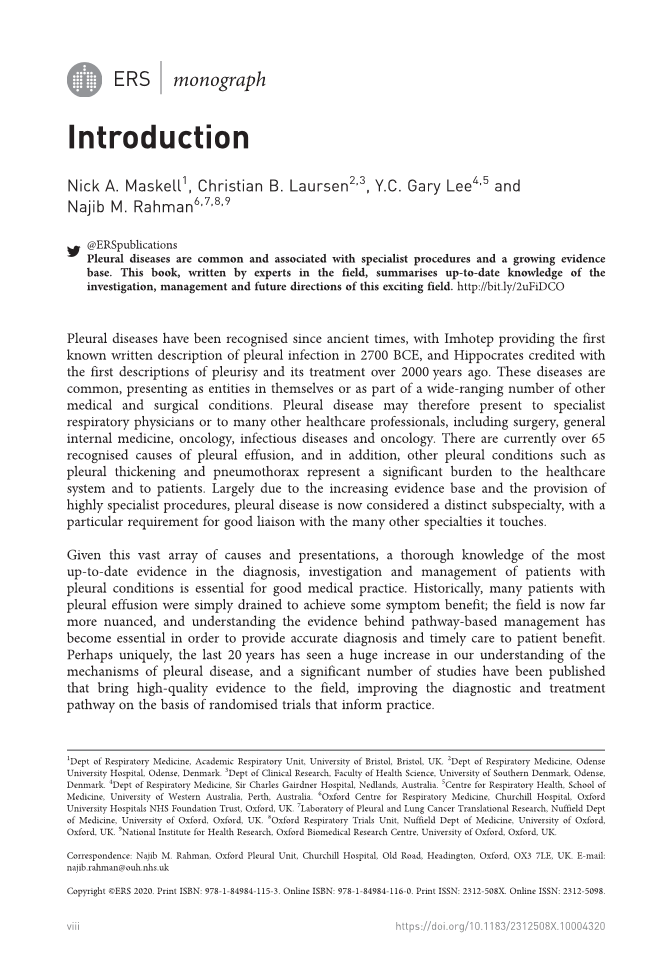ERS | monograph Introduction Nick A. Maskell1, Christian B. Laursen2,3, Y.C. Gary Lee4,5 and Najib M. Rahman6,7,8,9 @ERSpublications Pleural diseases are common and associated with specialist procedures and a growing evidence base. This book, written by experts in the field, summarises up-to-date knowledge of the investigation, management and future directions of this exciting field. http://bit.ly/2uFiDCO Pleural diseases have been recognised since ancient times, with Imhotep providing the first known written description of pleural infection in 2700 BCE, and Hippocrates credited with the first descriptions of pleurisy and its treatment over 2000 years ago. These diseases are common, presenting as entities in themselves or as part of a wide-ranging number of other medical and surgical conditions. Pleural disease may therefore present to specialist respiratory physicians or to many other healthcare professionals, including surgery, general internal medicine, oncology, infectious diseases and oncology. There are currently over 65 recognised causes of pleural effusion, and in addition, other pleural conditions such as pleural thickening and pneumothorax represent a significant burden to the healthcare system and to patients. Largely due to the increasing evidence base and the provision of highly specialist procedures, pleural disease is now considered a distinct subspecialty, with a particular requirement for good liaison with the many other specialties it touches. Given this vast array of causes and presentations, a thorough knowledge of the most up-to-date evidence in the diagnosis, investigation and management of patients with pleural conditions is essential for good medical practice. Historically, many patients with pleural effusion were simply drained to achieve some symptom benefit the field is now far more nuanced, and understanding the evidence behind pathway-based management has become essential in order to provide accurate diagnosis and timely care to patient benefit. Perhaps uniquely, the last 20 years has seen a huge increase in our understanding of the mechanisms of pleural disease, and a significant number of studies have been published that bring high-quality evidence to the field, improving the diagnostic and treatment pathway on the basis of randomised trials that inform practice. Copyright ©ERS 2020. Print ISBN: 978-1-84984-115-3. Online ISBN: 978-1-84984-116-0. Print ISSN: 2312-508X. Online ISSN: 2312-5098. Correspondence: Najib M. Rahman, Oxford Pleural Unit, Churchill Hospital, Old Road, Headington, Oxford, OX3 7LE, UK. E-mail: najib.rahman@ouh.nhs.uk 1 Dept of Respiratory Medicine, Academic Respiratory Unit, University of Bristol, Bristol, UK. 2 Dept of Respiratory Medicine, Odense University Hospital, Odense, Denmark. 3 Dept of Clinical Research, Faculty of Health Science, University of Southern Denmark, Odense, Denmark. 4 Dept of Respiratory Medicine, Sir Charles Gairdner Hospital, Nedlands, Australia. 5 Centre for Respiratory Health, School of Medicine, University of Western Australia, Perth, Australia. 6 Oxford Centre for Respiratory Medicine, Churchill Hospital, Oxford University Hospitals NHS Foundation Trust, Oxford, UK. 7 Laboratory of Pleural and Lung Cancer Translational Research, Nuffield Dept of Medicine, University of Oxford, Oxford, UK. 8 Oxford Respiratory Trials Unit, Nuffield Dept of Medicine, University of Oxford, Oxford, UK. 9 National Institute for Health Research, Oxford Biomedical Research Centre, University of Oxford, Oxford, UK. viii https://doi.org/10.1183/2312508X.10004320
